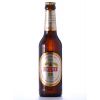EKU Brauerei - EKU 28
-
ABV:
11.0% -
Serving Temperature:
48-55°F -
Suggested Glassware:
Snifter or Tulip
EKU 28 walks a bit of a tightrope act between a standard eisbock and an amped-up, fortified doppelbock. While their recipe has never been released to the public, we do know that it spends an astonishing nine months lagering, during which time the temperature is lowered until the beer starts to freeze. EKU claims, however, that the amount of ice removed from the beer is not really a major factor in its potent level of alcohol or its concentrated flavor. One bit of info that they do acknowledge is the “28” in its name refers to the beer’s “degrees Plato,” which is the German method of calculating a beer’s “original gravity”— a measure of the density of fermentable sugars within the malt/water mixture that begins every batch of beer. To obtain the high ABV, a very large amount of malt must be used to infuse this mixture (known as wort—pronounced “wert”) with the sugary fuel that the yeast will convert into alcohol. An average beer typically has an original gravity of around 8-10 degrees Plato, so EKU 28 is loaded up with around three times the level of fermentable sugars as a “typical” beer.
On the nose, look for a big, caramel-heavy aroma. The impressive flavor offers up notes of thick caramel and freshly-baked bread, with light fruity hints, and not surprisingly, some notes of alcohol (producing a pleasant belly-warming effect that is quite satisfying around this time of the year). The healthy dose of hops creates a very well-crafted finish which balances EKU 28’s sweet overall flavor. You could say that this is a beer for special occasions, but honestly, as soon as you open one you’ve created a special occasion! We actually don’t recommend it with food; we think it’s much nicer as a digestif after a meal, like a port wine or cognac. A full-bodied cigar might work too, if you’re so inclined.
OK students, beer class is in session, please take your seats. Find a nice snifter or tulip glass, or some other similar vessel, and commence pouring your first international beer selection. We shall now begin with a short overview of the superb German beers you’ve received this month.
A number of different styles of beer hail from the town of Kulmbach in Northern Bavaria, but most significant and notable among them is the unique style that was invented there known as “eisbock.” Eisbock is a variant of the traditional and famous “bock” beer popularized by the brewers of Einbeck, Germany, about 175 miles to the northwest of Kulmbach. Originally, bock was not known as bock; instead, the term developed as a colloquialism as “Einbeck Bier” was corrupted into “Ein Bock Bier” (which translates as “one bock beer”), and eventually it simply became “Bock Bier.”
Many years after the bock style established itself in Bavaria, a variant known as “doppelbock” (double bock) was crafted, and this new style also grew in popularity. The Paulaner monks in Munich who invented this style named their beer Salvator (“savior”—and you can actually still buy Salvator and a number of other Paulaner beers at many good specialty beer stores and better beer establishments). Sometime after this, yet another variant of the bock theme was “accidentally” invented. According to local legend, a lone barrel of doppelbock was mistakenly left outside in the yard of a brewery in Kulmbach in the middle of winter’s icy grip. Snow piled up and hid the barrel from sight, and there it lay, forgotten, until spring. When the brewery staff discovered it, they found the barrel had split open a bit, releasing some of the contents, and what remained was partially frozen. After chipping off all the ice in and around the barrel, the enterprising brewers decided to sample the residual beer—after all, you can’t let good beer go to waste! Upon tasting the beer, they realized that it had become concentrated and was far richer than normal, with a significantly higher alcohol content (normal doppelbock is about 6.5-7.5% ABV). This serendipitous discovery was the result of the simple fact that water freezes before alcohol, and in the extreme cold of winter some of the water was forced out of the beer and froze, leaving a thicker brew behind. Essentially, the beer experienced an increase in the proportion of alcohol to volume, inspiring the brewers to set about duplicating, refining, and perfecting the “technique.” The result is one of the beers Franconia is most famous for, “eisbock” (ice bock).
Kulmbacher Eisbock, the originator of the style, is produced by Kulmbacher Brauerei, while a similar brew known as EKU 28 is made by their long time adversary in the same town, the EKU Brauerei. EKU is short for Erste Kulmbacher Union, so their name translates as “First United Kulmbacher Brewery” (we’ll cover what the “28” refers to in the review below). Begun in 1872, EKU was a fierce competitor of Kulmbacher Brauerei, as well as the other breweries located in the town, such as Sandlerbrau, Mönchshof, and Reichelbrau.
However, through corporate expansion, mergers and takeovers these breweries have been able to set aside their differences, and in 1996, all of them became unified within the same company, known by the simplest title among them: the Kulmbacher Brauerei AG (Kulmbacher Brewery Ltd.). Though united under the same organization and name, each brewery still operates independently, with each brewery producing their own array of well-regarded beers. We’re happy to see the merger didn’t cast any of these excellent beers into the dustbin of history. This month, we bring you two of EKU’s impressive and historic beers for you to savor. Prost!!
For more information (in German) about EKU and Kulmbacher, check out their web site at www.kulmbacher.de.

Unmatched Variety by style, brewery & country
Choose from Five different Beer Clubs offering unmatched variety by brewery,
country of origin, and beer style to suit your specific tastes.


